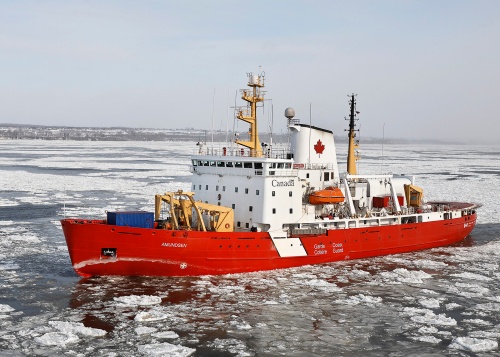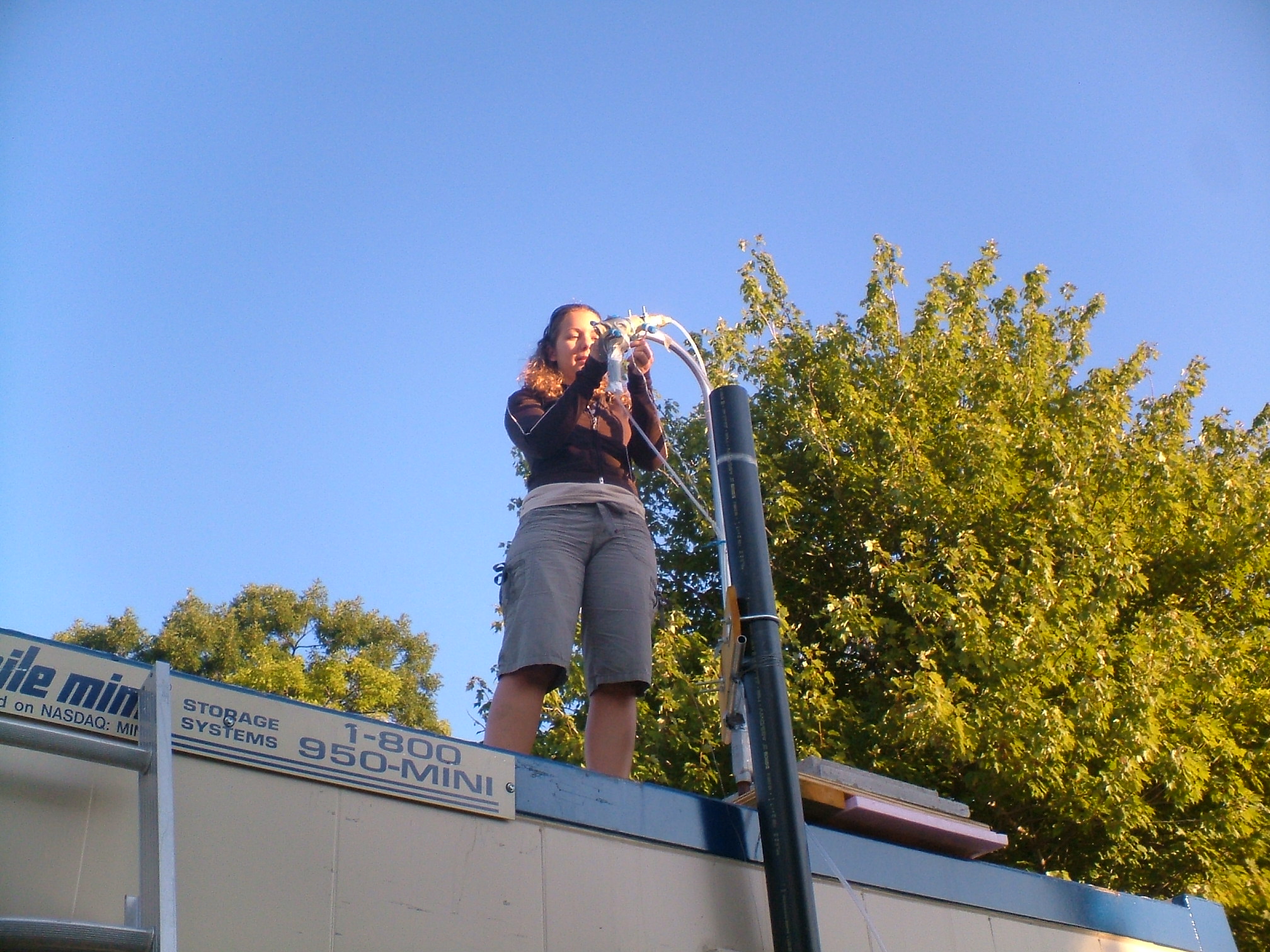Research Areas
Research in our group applies a range of analytical techniques to address questions about the processes that control the composition of the atmosphere. Our focus is on acquiring and interpreting field measurements of concentrations and fluxes, but we also do some work with monitoring data and collaborate extensively with modelers.
Most of our research falls under the four broad themes:
- Measurements of ammonia and particle composition
- Atmosphere-biosphere exchange of trace gases and particles
- Fate of organonitrogen in the atmosphere
- Observational constraints on urban air quality and greenhouse gas emissions
Measurements of ammonia and particle composition
Our involvement in the collaborative and interdisciplinary NETCARE project has provided a unique opportunity to explore NH3 in the remote polar atmosphere. Our observations of neutralized particles and relatively high levels of NH3 in the Arctic marine boundary layer in 2014 allowed us to identify a significant role for colonies of migratory seabirds to impact the composition of the Arctic marine atmosphere (Wentworth et al., 2016). Using a chemical transport model with detailed aerosol microphysics, these seabird emissions are found to exert a very strong control on the radiative forcing of the Arctic atmosphere, suggesting the potential for climate feedbacks (Croft et al., 2016). In 2016, we returned to the Arctic, measuring ammonia both from the icebreaker and at Alert, and have intriguing evidence that the tundra can also act as a source of ammonia to the Arctic atmosphere (Wentworth and Moravek, in prep).
Atmosphere-biosphere exchange of trace gases and particles
Our group has pursued a number of projects that directly or indirectly measure surface-atmosphere exchange of reactive nitrogen and other atmospheric constituents. Our initial work was carried out at Haliburton Forest, a region that historically received very large reactive nitrogen inputs, making it an ideal location to study links between the carbon cycle, nutrient inputs, and management practices. During the summer and fall of 2011, we found evidence of net uptake of CH4 in the tower footprint and identified soil moisture and wind speed as the key controls on the magnitude of the flux (Wang et al, 2012). Continuous measurements of CO2 fluxes from 2010 through 2012 demonstrate that the tower footprint typically represents a small source of carbon annually, but that a 3-day heatwave in May 2010 that severely damaged emerging leaves resulted in significant carbon losses over that year’s growing season (Geddes et al., AgForMet, 2014). Eddy covariance measurements of size-resolved particle fluxes made in the summer and fall of 2011 showed that particle size, leaf area index and atmospheric stability were all important controls on the direction and magnitude of particle fluxes (Petroff et al., 2018). At both Haliburton and the University of Michigan Biological Station (UMBS), we measured eddy covariance fluxes of nitrogen oxides during the summers of 2011 and 2012, respectively, and found that dry deposition accounted for 22 and 40% of the total NOy deposition at the sites. In 2016, we returned to UMBS as part of the PROPHET-AMOS campaign, where we focused on simultaneous above-canopy measurements of NO and NO2 fluxes. Our observations, along with 1D canopy modelling, carried out in collaboration with Allison Steiner, indicate that emissions of NOx from the local ecosystem in very small, and that a ‘morning pulse’ of NOx observed on polluted days can be attributed to the photochemical conversion of NOz to NOx (Shi, Kavassalis et al., in prep).
Fate of organonitrogen in the atmosphere
While ammonia is the most abundant form of reduced nitrogen, many other types of organic reduced nitrogen are emitted to the environment from natural, agricultural and industrial sources. We developed an online method for measurements of the organic analogues of ammonia, alkyl amines, in the gas and particle phases (VandenBoer et al., 2012). By combining size-resolved daily integrated samples of amines in particulate matter with online hourly measurements of amines in the gas and particle phases, we were able to show that amines are present at much lower levels than ammonia in the gas and bulk particle phase. However, as one moves to increasingly small particle sizes, amines can become more significant, implying that they may play a more significant role in the early stages of particle growth, or that they are reacted away during particle aging (VandenBoer et al., 2011).
In collaboration with Jon Abbatt’s group, we carried out smog chamber measurements of the oxidation of ethanolamine (a benchmark solvent for carbon capture and sequestration) and found a short lifetime against photochemical oxidation, a process that produces a gas phase amide (Borduas et al., 2013). Further experimental and theoretical work investigated the kinetics, mechanism, and products of amide oxidation, showing that the toxic isocyanates are common products (Borduas et al., 2015). We revisited the pH-dependent hydrolysis kinetics of HNCO and provided the first temperature-dependent solubility measurements for this compound (Borduas et al., ACP, 2016). Having identified HNCO and the “CO2 of organonitrogen” (i.e. the final product of atmospheric oxidation), we are now carrying out kinetics experiments to identify possible aqueous phase reaction pathways for HNCO that may be more important than hydrolysis alone. We are also studying condensed phase reactions of reduced nitrogen from the perspective of their influence on the reactive nitrogen budget, a complementary perspective to the interest of others in the production and loss of ‘brown carbon’.
Observational constraints on urban air quality and greenhouse gas emissions
More than 80% of Canadians live in urban areas, and these regions of intensive human activity result in concentrated emissions of air quality pollutants and greenhouse gases. Across the world, cities are looking for strategies to reduce emissions to protect public health and mitigate climate change. We have exploited observational data from long-term monitoring networks to identify which precursor emission reductions will be most effective in decreasing the secondary pollutant ozone, and how chemistry and meteorology interact to contribute to poor air quality (Geddes et al., 2009, Pugliese et al., 2014, Wentworth et al., 2015).We developed a unique high-resolution Southern Ontario CO2 Emission inventory (SOCE) and evaluated it against monitoring data by working with Environment and Climate Change Canada to simulate urban scale CO2concentrations in GEM-MACH (Pugliese et al., 2018). Our next step is to make simultaneous measurements of CO2, CO, CH4, NO, NO2, N2O and NH3 in the urban environment and use enhancement ratios between the different pollutants to understand the relative importance of emissions from different source sectors (e.g. cars, trucks, power plants, wastewater treatment).

















